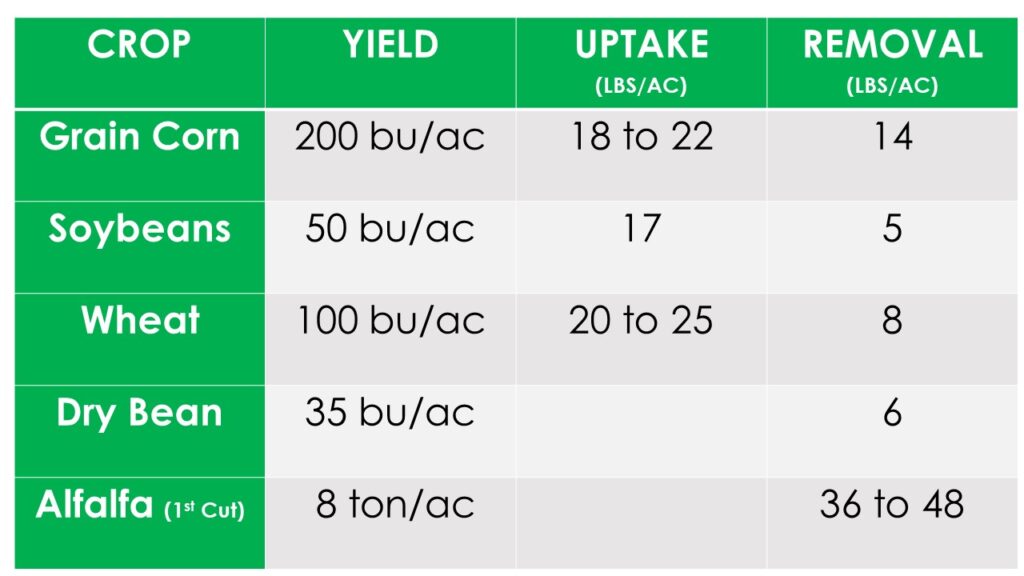
Sulphur (S) has become the topic of much conversation over the last few years. Deficiencies are becoming more common in more crops as atmospheric levels lower.
There are a number of factors that have led to these decreasing levels. The largest reason is that emissions restrictions have led to cleaner industrial activity leading to a reduction in the amount of sulphur being emitted into the atmosphere and replenishing the soil in the form of acid rain. The switch from superphosphate (0-20-0 12S) to MAP (11-52-0) as the most common form of phosphate added to the issue. Lastly, a reduction in the amount of manure being applied to fields in Ontario has also led to declining soil levels.
This trend of the lowering amount of sulphur in the atmosphere, plus the higher demand for sulphur and all nutrients as crop yields continue to rise has made deficiencies and the need for application of sulphur to crops more frequent.

ABOVE: Atmospheric deposition of Sulphur has decreased greatly from 1990 to 2015.
Image Source: Hoosier Ag Today
In the Plant and Soil
Sulphur plays an important role in the development of all crops as it is needed for the making of many proteins that help form chlorophyll and promote nodulation in legumes.
Most sulphur in the soil is stored in organic matter, being mineralized into plant available sulphate (SO42-) as the organic matter breaks down. Availability is determined by the rate of mineralization and usually only 1-5% of organic sulphur is converted into sulphate over the growing season. It moves into the soil solution after mineralization and can be prone to leaching.
Sulphur Uptake and Removal
Demand and uptake for sulphur varies by crop, with alfalfa having the highest need among field crops.

Sulphur Deficiency Diagnosis
Symptoms of sulphur deficiency vary by crop, but it is commonly associated with a pale yellowing (chlorosis) of the younger leaves, followed by the entire plant. These symptoms are present in wheat, soybeans, dry beans and alfalfa. In corn symptoms are very similar but can sometimes appear as interveinal chlorosis.
Because sulphur is most present in the soil organic matter, deficiency most often shows up in the low OM, sandy knolls first. However, heavier clay soil can show deficiencies as well.
Unfortunately Ontario does not have a reliable method of testing soil for sulphur. Sulphur analysis is offered by some laboratories but because it is a leachable nutrient, a test only shows what is available at that current point, and not necessarily what will be there for the crop through the season. Therefore it should not be used to make fertilizer recommendations. Tissue testing can be an option if you think sulphur may be an issue. For wheat and alfalfa, the plant is likely deficient if %S is below 0.25%.

ABOVE: Sulphur deficiency in winter wheat.
Image Source: Field Crop News
Suphur Deficiency Management
Recent research in Ontario has suggested that 10-15 lbs/ac of sulphur is optimal for winter wheat, and although less research has been done, corn seems to respond to similar rates. Soybeans are just starting to be researched to see if there is an adequate response from applying sulphur to the crop, deficiencies are less commonly present. Fertilizer sources of sulphur are listed below:
Dry Products
- Micro Essentials Sulphur Zinc (MESZ) 12-40-0 10S (5% elemental sulphur, 5% sulphate)
- Ammonium Sulphate 21-0-0 24S
- Pelletized Gypsum 21%Ca 16%S
- Potassium Sulphate 0-0-50 17S
- Magnesium Sulphate (Epsom Salts) 9%Mg 13%S
- Sulphate of Potash-Magnesia (KMAG/TRIO) 0-0-22 20S 12Mg
- Elemental Sulphur 90%S (not available to plant)
Liquid Products
- Ammonium Thiosulphate 12-0-0 26S
Additional Sources:
Field Crop News